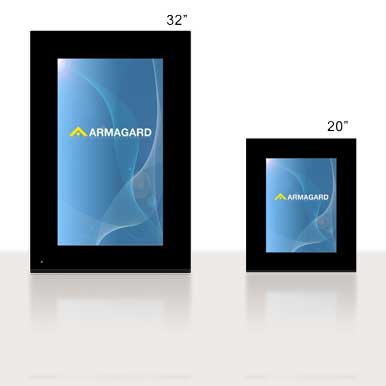Advertising Displays – Shapes, Sizes and Orientation
Posted by: Richard Williams | Posted on: | 0 Comments
As with other forms of promotion, when it comes to digital advertising the most important factor is content. The better the content, the more likely people will engage with it. However, other factors can also help when it comes to making digital advertising displays more noticeable and engaging.
Size of Advertising Displays

Portrait orientation
For indoor advertising displays, size doesn’t make too much difference. Most indoor screens are between 36” and 46” inches and in the scant research into digital advertising that has been conducted, there has been no reported difference that suggests that larger screens are more effective.
However, it is a different story outside. People view outdoor advertising displays in a different manner to indoor displays. Firstly, the dwell time for outdoor advertising displays is briefer than for indoor displays. For this reasons both content and advertising display need to work that much harder to engage with people. This means that content needs to be bold and prominent, so a larger screen is more effective. Secondly, people tend to view outdoor advertising displays from farther away. This means that the display needs to be larger to maintain effectiveness over longer distances.
Orientation of Advertising Displays
Depending on the information that the advertising display is showing, orientation makes a big difference. There has been a tradition of placing digital advertising in portrait orientation, especially in indoor environments. However, this has more to do with space saving than to do with the effectiveness of a vertical screen. Landscape mode could be a far better solution for getting a screen noticed as most people are used to seeing a display that way up, as it’s the orientation of their TV at home.
Landscape is also more effective at displaying large amounts of text as more words can be fitted on each line. This is why many digital information screens are positioned in this orientation.
Shape of Advertising Displays
While most LCD screens come in the roughly the same shape although aspect ratios differ slightly. However, the enclosures that house advertising displays come in many different guises. When it comes to getting a display noticed, the housing containing the screen and where it is mounted, can make a big difference. Displays flat against a wall such as the traditional digital poster are easily overlooked, while a kiosk or totem display is far more prominent.
Floor standing totem displays can make for a standout feature in a busy store, building entrance or even outside, helping to attract people’s attention to the content. Many high street advertising companies use this form of advertising display (both digital and static) because of the prominence and often position them in the middle of thoroughfares facing the oncoming audience.
Post shortlink:
Popular Products
LCD Enclosure
Need armor for your LCD/LED screen(s)? Outdoors or inside the versatile LCD enclosure protects against thieves, vandals & the weather. Installation idea: NFL stadiums.
Outdoor Digital Signage
Exclusive 46” outdoor screen protection. Dubbed the ‘Totem’, due to its distinct design, it repels damage threats, but attracts audiences. Installation idea: Drive-thru restaurants.
Portrait Flat Panel Enclosure
Safeguard your eye-level advertising display screen(s), indoors or outdoors. Completely customizable, add exciting features like touch screen technology. Installation idea: Restaurant frontages.
Indoor Digital Signage
Popular purchase for retail outlets! Great for ‘point of sale’ persuasion, boost your brand with static & motion advertising from a single unit! Installation idea: Mall of America.




